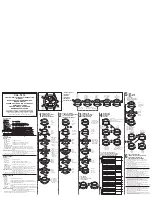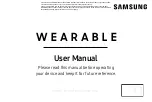
SETTING THE TIME MANUALLY
If there DCF reception is not possible, the watch can also be set manually.
However, the precondition is that the 12 o’clock positioning of the hands has been
performed correctly (see “Positioning the hands”) and no DCF signal has been re-
ceived.
-
Press button (A) briefl y.
-
On the display (C) „00“ is shown.
-
Now set the correct time, using button (A) as described in „Positioning the
hands“.
-
Press button (B) briefl y, to complete the settings.
After setting the time manually, a date cannot be set.
The watch continuously tries to detect the DCF signal and will set automati-
cally to DCF time, if a signal has been received successfully. This will be indi-
cated by a „0“ in the reception status display (see „Display“).
DISPLAY
On the display (C), the date is usually shown.
-
Press button (B), to view the reception status. This status shows the number of
days where it has not been possible to detect the DCF signal.
-
Press button (B) again, to view the seconds.
-
Press button (B) again, or wait a few seconds, to return to the date display.
SETTING THE TIME ZONE
If you are out of the DCF time zone, you can adjust the time zone manually.
-
Press button (A) briefl y.
-
On the display, the current set hours are shown.
-
Press the button (A), until the correct hour is set. The hands run to the appropri-
ate position. The date will be adjusted afterwards, if necessary.
-
Press the button (A), for more than 3 seconds to reset the time to DCF time.
If the time has been set to a time zone outside the DCF time zone (+/- 1 hour),
no automatic DCF synchronisation is performed and no manual DCF recep-
tion is possible.
CHANGING THE BATTERIES
-
If „Lo“ and the date are shown alternately on the display (C), the battery has to
be replaced.
-
Replacing the battery should be done by a specialist, using special clockmaker
tools and professional knowledge.
-
To replace the battery, the back of the case is removed.
-
The battery can then be removed from its holder and be replaced.
RESTART AFTER REPLACING THE BATTERY
-
After replacing the battery, the Display (C) shows „Po“.
-
Position the hour and minute hands to the 12 o‘clock position, as described in
„Positioning the hands“.
-
Now the watch attempts a DCF reception and will set itself to the correct time,
after successful reception.
RESET
-
If your watch malfunctions, or if it can no longer be operated, press the buttons (A)
and (B) simultaneously for more than 3 seconds, until the display (C) goes out.
-
After releasing the buttons, the integrated microprocessor performs a reset. All
the settings are deleted and the display (C) shows „Po“.
-
Now proceed as described in „Restart after Replacing the Battery“.
MAINTENANCE AND CLEANING
To clean the outside of the watch, a dry, soft, clean cloth is suffi cient. For heavier
soiling of the exterior, you can moisten the cloth slightly with lukewarm water.
Clean the clock very carefully, otherwise you may scratch it.
Do not press too strongly on the glass cover as this may cause scratch marks.
SHOCK RESISTANCE
In normal use, the wristwatch is protected against shocks. Nevertheless, do not ex-
pose the device to extreme shocks such as might occur if the device falls on to a
hard surface. This may damage the clockwork or the position of the hands may be
changed (Positioning the hands is described earlier in this manual).
WATER TIGHTNESS
Please observe the marking on the watch and its meaning.
Marking Suitability
-
Watch must be protected from water
3 ATM
Washing your hands, rain, water spray
5ATM
see above + bathing, showering
10ATM
see above + swimming, snorkelling
20ATM
see above + free diving
SHORTENING THE STRAP
-
For minor adjustments, move the spring peg on the catch on the strap into an-
other hole.
-
If larger adjustments are necessary, one or more links can be removed from the
strap. To do so, please contact a clockmaker, who has suitable tools for this kind
of work.
DISPOSAL
a) Product
Electronic devices are recyclable waste and must not be disposed of in the
household waste!
Please dispose of the product, when it is no longer of use, according to the
current statutory requirements.
b) Batteries and rechargable batteries
As the end user, you are required by law (Battery Ordinance) to return all used bat-
teries/rechargeable batteries; disposal of them in the household waste is prohibited!
Contaminated batteries/rechargeable batteries are labelled with these sym-
bols to indicate that disposal in the domestic waste is forbidden. The sym-
bols for the relevant heavy metals are: Cd=Cadmium, Hg=Mercury, Pb=Lead
(the description is written on the battery/rechargeable battery e.g. under
the dustbin symbols).
You can dispose of your used batteries/rechargeable batteries free of
charge at your community‘s collection point or any place where batteries/
rechargeable batteries are sold!
You thereby fulfi l your statutory obligations and contribute to the protection of the
environment.
DECLARATION OF CONFORMITY (DOC)
The manufacturer hereby declares that this product conforms to the fundamental
requirements and the other relevant regulations of Directive 1999/5/EC.
You can fi
nd the Declaration of Conformity for this product at
www.conrad.com.
TECHNICAL DATA
Operating voltage:
1.55 V/DC (button cell SR626SW)
Battery life:
approx. 2 years
These operating instructions are a publication by Conrad Electronic SE, Klaus-Conrad-Str. 1,
D-92240 Hirschau (www.conrad.com). All rights including translation reserved. Reproduction by
any method, e.g. photocopy, microfi lming, or the capture in electronic data processing systems
require the prior written approval by the editor. Reprinting, also in part, is prohibited. These ope-
rating instructions represent the technical status at the time of printing. Changes in technology
and equipment reserved.
© Copyright 2011 by Conrad Electronic SE.


























